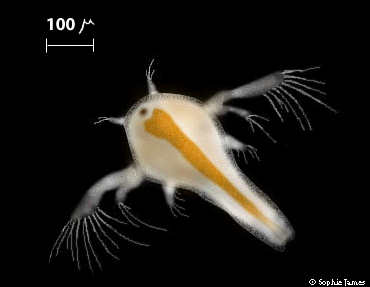



Testing for Hits
Researchers test whether sponge extracts can disable proteins and kill brine shrimp and cancer cells.
One cocktail of sponge chemicals can appear the same as any another--extracted from the sponge, the chemicals ooze as an oily goo. Yet Crews's group must distinguish the poisonous mixtures from the mild ones. To determine toxicity, Crews's researchers test the various mixtures of sponge goo on a living creature. The sacrificial lamb of Crews's laboratory is the lowly brine shrimp, an animal so small that it can swim in the volume of a rain drop. Instead of rain drops, though, the researchers make the shrimp swim in water spiked with sponge chemicals. The death of brine shrimp points to cellular toxins lurking in the sponge extract. The next step is to learn whether the shrimp killers can do even more. Can they kill cancer cells?
Medicinal chemists have shifted their focus over the years from testing compounds on the quickly dividing leukemia cell cultures, which are relatively easy to kill, to the more recalcitrant solid tumor cells derived from the colon, breast, lung, pancreas and prostate. "In the drug discovery programs of the past, people have mainly used leukemias as the touchstone for activity," says Fred Valeriote, a biophysicist at Wayne State University who collaborates with Crews. "Now there are pretty good anti-leukemia and anti-lymphoma compounds, but these have minimal activity against solid tumors."
Valeriote tests Crews's extracts on panels of solid tumor cells. He saturates a paper disc with the extract's chemicals and places it in the middle of a petri dish that has been seeded with cancer cells. He selects the winners as those extracts that inhibit the growth of solid tumor cells more than they do the growth of normal cells or even leukemia cells. By these criteria, Valeriote reports winners at a rate between 1 percent and one-half of 1 percent of the few thousand extracts he tests each year. The next stage of testing further winnows the list of contestants. Only one in ten of the extracts that kill tumor cells in a petri dish actually shrinks tumors in mice. The rest either deal a lethal blow to the animal, require a huge dose to shrink tumors, or do nothing at all (the animal's metabolism might destroy the toxin).
For additional testing on tumor cells, Crews also sends his extracts to researchers at the NCI. They test the chemicals on 60 different tumor cell lines. The successful extracts kill a few types of cancers and leave alone the rest. Scientists reason that the toxins that cut down all types of tumor cells will probably also blaze through a patient's normal cells.
Some scientists try to be even more selective in their tests on the extracts. For example, Kenneth Bair, a medicinal chemist at Navartos Pharmaceuticals Corporation, and coworkers want to know whether the toxins can cripple particular proteins that are mutated or overexpressed in cancer cells. The team isolates these cellular components responsible for transforming normal cells into cancerous ones and then tests how well the sponge extracts disrupt the protein's functions. The researchers hope to find extracts that kill cancer cells harboring these protein defects but that leave alone normal cells.




